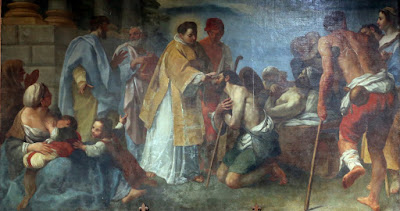 |
| Marco Benefial Portrait of British painter John Parker 1761 oil on canvas Accademia di San Luca, Rome |
 |
| attributed to Marco Benefial Portrait of an Old Woman ca. 1750 oil on canvas Palazzo Buonaccorsi, Macerata |
 |
| Marco Benefial Jonah ca. 1718 fresco Basilica di San Giovanni in Laterano, Rome |
 |
| attributed to Marco Benefial Portrait of a Young Woman before 1764 oil on canvas Palazzo Buonaccorsi, Macerata |
 |
| attributed to Marco Benefial Portrait of a Young Woman before 1764 oil on canvas Palazzo Buonaccorsi, Macerata |
 |
| Marco Benefial Rest on the Flight into Egypt ca. 1750 oil on canvas Musée des Beaux-Arts de Carcassonne |
 |
| Marco Benefial Vision of St Catherine of Genoa 1747 oil on canvas Palazzo Barberini, Rome |
 |
| Marco Benefial Vision of St Philip Neri 1721 oil on canvas Fitzwilliam Museum, Cambridge |
 |
| Marco Benefial St Lawrence healing the People ca. 1721-25 oil on canvas Museo del Colle del Duomo, Viterbo |
 |
| Marco Benefial St Margaret of Cortona discovering the Corpse of her Lover before 1764 oil on canvas Musée Fesch, Ajaccio, Corsica |
 |
| Marco Benefial Baptism of San Tranquillino di Roma ca. 1721-25 oil on canvas Museo del Colle del Duomo, Viterbo |
 |
| Marco Benefial Seated Sibyl 1733 drawing (study for fresco) British Museum |
 |
| Marco Benefial Figural Studies before 1764 drawing Metropolitan Museum of Art, New York |
 |
| attributed to Marco Benefial Youth kissing an outstretched hand before 1764 drawing Metropolitan Museum of Art, New York |
 |
| Marco Benefial Self Portrait 1731 drawing Getty Museum, Los Angeles |
"If the Rococo phase forms, as it were, the anti-conventional 'left wing' of Marrattesque classicism, a new 'right wing' began to emerge for which that insipid manner was too Baroque and formalistic. It was mainly three artists who made heroic attempts at leading Roman painting back to a sounder foundation: [among them] Marco Benefial (1684-1764), half French, pupil of the Bolognese Bonaventura Lamberti, by means of an intense study of nature and by returning to the classical foundations of Raphael and Annibale Carracci. . . . In varying degrees, all three artists take up special positions on the borderline between Rococo and Neo-classicism. These masters stuck tenaciously to Late Baroque formulae of composition. Nor is the lyric, languid, and often sentimental range of expressions really divorced from contemporary painting."
– Art and Architecture in Italy, 1600-1750 by Rudolf Wittkower (1958), revised by Joseph Connors and Jennifer Montagu for Yale University Press (1999)